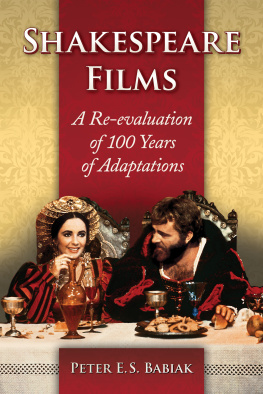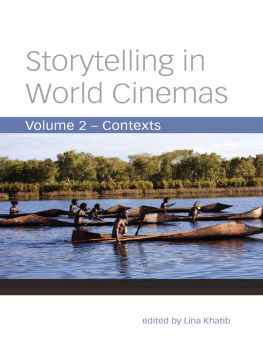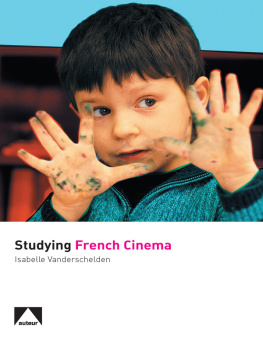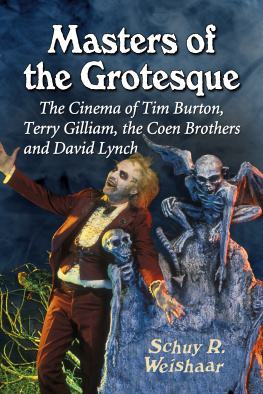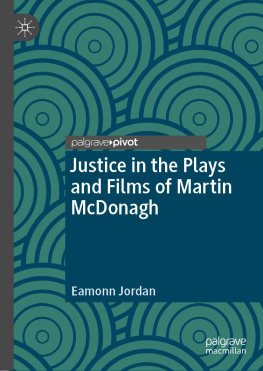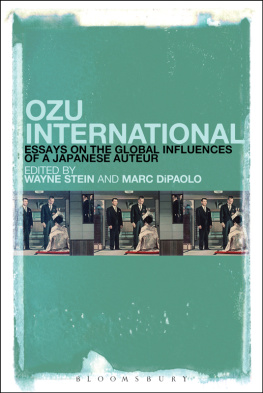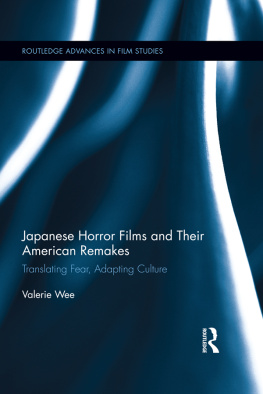
Shakespeare Films
A Re-evaluation of 100 Years of Adaptations
Peter E.S. Babiak

McFarland & Company, Inc., Publishers
Jefferson, North Carolina
LIBRARY OF CONGRESS CATALOGUING DATA ARE AVAILABLE
BRITISH LIBRARY CATALOGUING DATA ARE AVAILABLE
e-ISBN: 978-1-4766-2352-8
2016 Peter E.S. Babiak. All rights reserved
No part of this book may be reproduced or transmitted in any form or by any means, electronic or mechanical, including photocopying or recording, or by any information storage and retrieval system, without permission in writing from the publisher.
Front cover: Elizabeth Taylor and Richard Burton in The Taming of the Shrew, 1967 (Columbia Pictures/Photofest)
McFarland & Company, Inc., Publishers
Box 611, Jefferson, North Carolina 28640
www.mcfarlandpub.com
Preface
Prior to the turn of the last century, much of the critical literature that deals with the adaptation of Shakespeares plays in mainstream film has been limited in its usefulness for two reasons. Firstly, there has been a tendency to emphasize the importance of the director as the auteur (or sole creator) of a filmed adaptation of a play, which generally means that films have been analyzed almost exclusively in terms of the directors vision and techniques. This has led to a tendency to ignore patterns of similarity that exist between works produced by different filmmakers working in the same socio-historical period. Secondly, some established paradigms for the classification of filmed adaptations of canonized literary works have not adequately addressed the complexities of cinematic adaptations of Shakespeare where the language is contemporary, the settings modern or alternative, and the play reduced to subtext. As a result, some critics dealing with Shakespeare on film have assumed that the period from 1971 to 1989 represents an 18-year gap during which no filmed adaptations of Shakespeare were attempted in mainstream cinema. Prior to the turn of the century, critical studies of Shakespeare in the cinema have tended to avoid discussion of films that cannot be adequately evaluated under established critical paradigms.
Over the last decade, material that had not previously been addressed in studies of Shakespeare in the cinema has begun to attract scholarly attention, both in conference presentations and in peer-reviewed articles. Simultaneously, theorists have noticeably begun to move away from the insistence on the text itself mandated by formalist criticism, and have begun to develop new paradigms for examining the relationship between a seminal play-text and a resultant film adaptation. This study attempts to take the next logical steps by filling in the gaps between these recent theorists and these recent practitioners in adaptation studies, and the gaps between recent adaptation theory and practice and 20th-century adaptation theory and practice.
This study undertakes a critical reexamination and fundamental repositioning of the standard canon of films based on Shakespeares plays. It has two main arguments. Firstly, it is proposed that the crucial element distinguishing one film from another is the impact of social, cultural and historical contexts. Secondly, it argues for the inclusion of films that up to now have not been considered part of the canon of Shakespeare in the cinema. Again, the influence of contemporary cultural and sociological contexts is the central element in this analysis. This approach has led to a largely historical format for the study. Some chapters are devoted to specific periods of time, as the clearest way to take account of the contextual influences; other chapters reevaluate the work of established auteurs of Shakespeare in the cinema by contextualizing their work within the socio-historical period of its production. This approach preserves the established canon of Shakespeare in the cinema, while providing a more inclusive paradigm for inclusion of works into the canon than had previously been available.
This study would not have come into existence without the work of Kenneth Branagh, for it was Branaghs film of Henry V that instigated my fascination with Shakespearean film adaptations. Although my chapter on his work presents my analysis of three of his adaptations of Shakespeare, what I have neglected to communicate in my scholarly discussion is my enjoyment of them and enthusiasm for them. When researching a paper on Henry V for the 2005 annual conference of the PCA/ACA, although I had viewed the film at least nine times prior to preparing the paper, I was still shocked to realize how good the film is. I also remember anxiously anticipating the 1994 release of Much Ado About Nothing on home video, and just as anxiously anticipating the 1997 release of Hamlet on home video, as I was dying to see both films again, and to share them with friends and relatives. Although I had already seen several of the other works discussed in this study, it was Henry V that led to my fascination with this subject, and it is my hope that this study will instill this fascination in others.
This study would not have been possible without the loving support of my family, including my parents, partner and children, or the editorial support of the members of my supervisory and examination committees. My supervisory committee was comprised of Christopher Innes, the Canada Research Chair in Performance and Culture; Marie Rickard, the Master of Winters College at York University; and Derek Cohen, of the Graduate Program in English at York University. The examination committee included Richard Vela, PCA/ACA Area Chair for Shakespeare on Film and Television; Fran Beer, of the Graduate Program in English at York University; and Livy Visano, of the Department of Social Science at York University. I am pleased and honored to note that my association with all of these people has also extended beyond the parameters of this project, and I am deeply grateful for their ongoing support in a variety of capacities and efforts.
A portion of Chapter 3 appeared in Cineaction 41 in Maintaining the Dual Perspective: Orson Welles and Chimes at Midnight (1996), and portions of chapters 4 and 7 appeared in Or Image of that Horror: The Apocalyptic Visions of Peter Brook and Akira Kurosawa in The Silk Road of Adaptation: Transformations Across Disciplines and Cultures (ed. Laurence Raw; Cambridge Scholars, 2013). I am grateful to the presses for granting permission to republish that work.
I would like to mention the names of a few people who did not see the completion of this study, but should be remembered here. David Porter provided much badly-needed guidance during my early life, and his influence is greatly missed. Brendan Gabis was a great friend during a period of transition in my life, and left us far too early. Don Fine greatly influenced my decision to pursue graduate studies and become a teacher myself; the memory of his classroom informs the practice of mine. As one of the last duties of his professional career, and in the last few months of his life, Robert White recommended me for acceptance into doctoral-level studies.
Finally, neither my paternal nor my maternal grandparents saw the completion of this study; however, their memory and example enabled it to be completed.
Introduction
A Brief Look at Adaptation Studies
Prior to the turn of the last century, the usefulness of studies dealing with filmed adaptations of canonized literary texts has been limited by the tendency of critics to view a seminal literary text as a discrete entirety, and to evaluate the effectiveness of a film adaptation in terms of the thoroughness with which it represents that entirety which is the seminal literary text. This has led to a preponderance of both overt and covert fidelity criticism in published adaptation studies throughout the history of the field. In
Next page
